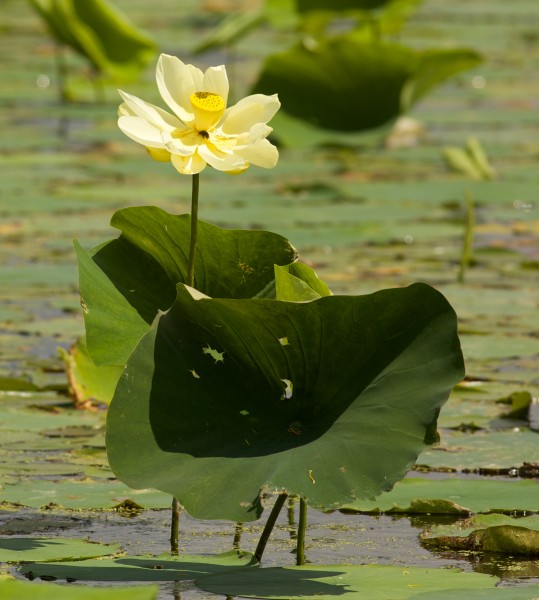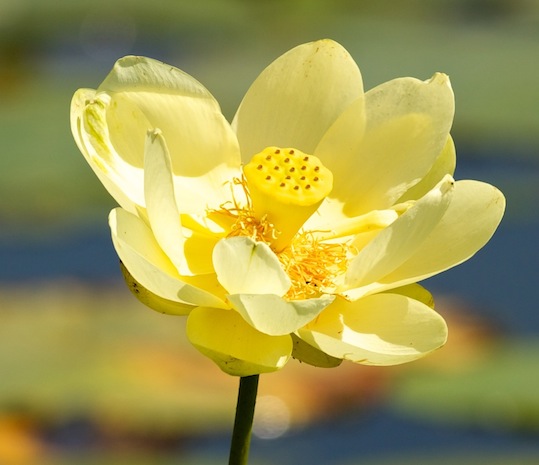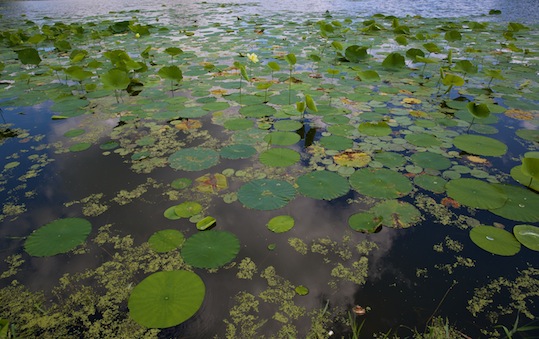
Conservation photographer Arlene Koziol captured the fleeting bloom of the American Lotus in Warner’s wetland on July 22, 2014. In a nature walk with Wild Warner’s education coordinator, Paul Noeldner, Koziol also captured our Sandhill Crane family, a new Wood Duck family, and the beauty of the new wet prairie island, once used to bombard Rhythm & Booms fireworks into the wetland.
“Wild Warner Park is a gem right in the midst in a big city,” she writes. “New lives – Sandhill Crane Colt, Wood Duck family and nesting Red-winged Blackbirds. Stunning Lotus flowers , seen in many cultures as being symbolic of rebirth. I see the lotus representing the rebirth of Wild Warner Park.”

The American Lotus (Nelumbo lutea) is often confused with the common Water Lily, but is a distant cousin, as it is to the sacred lotus flowers of many cultures. It is marked by huge leaves, long stalks, and six-inch, intricate flowers that open one day, close that night, and open one more day before dropping their petals.

The plant was a food source for Native Americans. It is also a grocery store for wildlife, as explained on the Texas A&M Aquaplant Web site:
“Submerged portions of all aquatic plants provide habitats for many micro and macro invertebrates. These invertebrates in turn are used as food by fish and other wildlife species (e.g. amphibians, reptiles, ducks, etc.). After aquatic plants die, their decomposition by bacteria and fungi provides food (called “detritus”) for many aquatic invertebrates. The large acorn like seeds of lotus are utilized by some ducks and other wildlife. Beavers and muskrats will consume the rhizomes.”
Here is a good background piece from Loyola University in New Orleans.
Koziol, who has photographed nature all over the world, was in Madison photographing Cherokee Marsh with Noeldner, who then offered to show her the Warner Park Sandhill Crane family.
“The first thing that caught my eye were the lotus blossoms. Many years ago when we were visiting Japan, I was driving with a non-English speaking friend. He got phone call and became quite excited. We turned around and sped back to his home. The family was in the backyard looking at a muddy pond. There was one yellow lotus plant booming.
“It was explained to me in Japan the lotus flower is revered for its ability to rise from murky waters to a beautiful blossom. This is symbolic of rising above suffering and struggle to happiness and a spiritual awakening. In Japan, many people stop their day to appreciate the beauty and think about the meaning of the lotus blossom.
“There was so much to observe and photograph at Wild Warner. Hours went by and I felt that I was just getting started. The next day I brought my 3 year old grandson to see Wild Warner. He loved the insects, painted turtles and the Crane family.”
Here is a link to Arlene Koziol’s photos of Warner Park, and her other conservation photos from all over the world.
You must be logged in to post a comment.